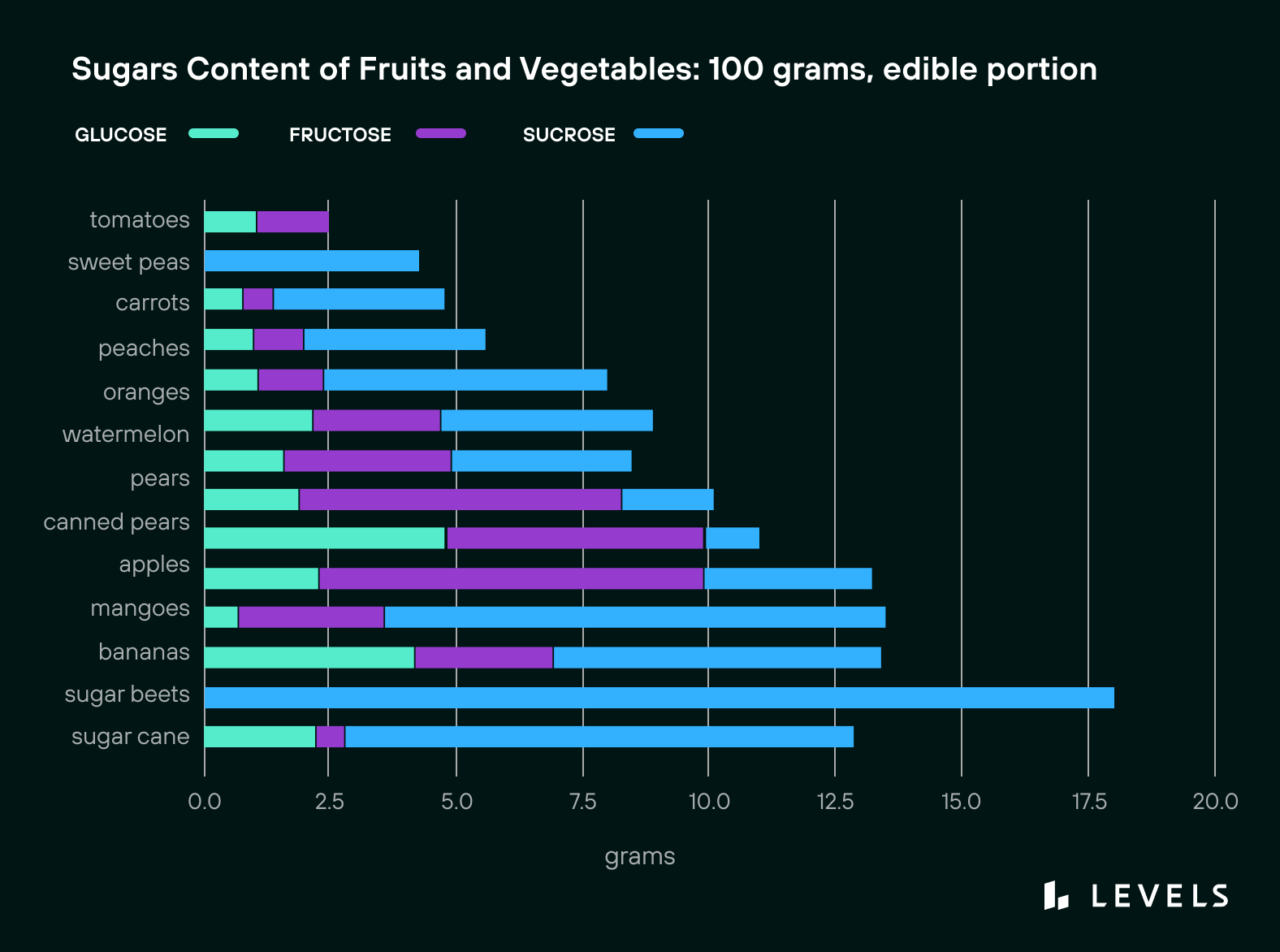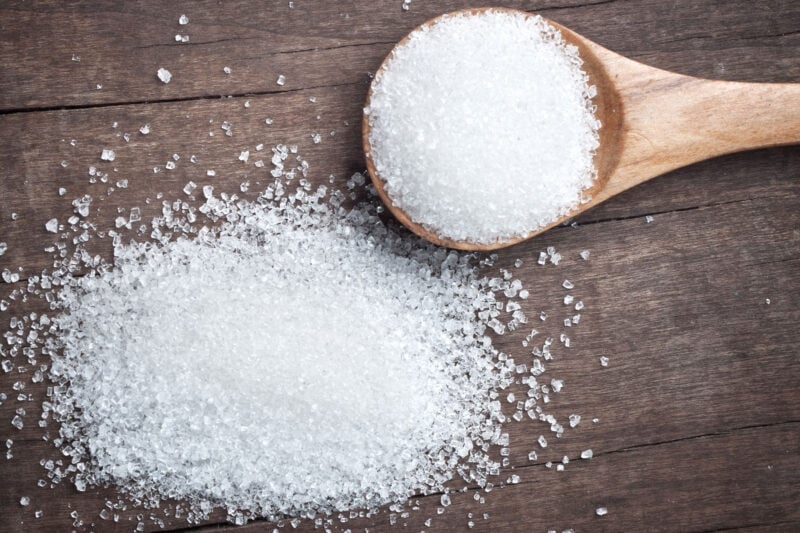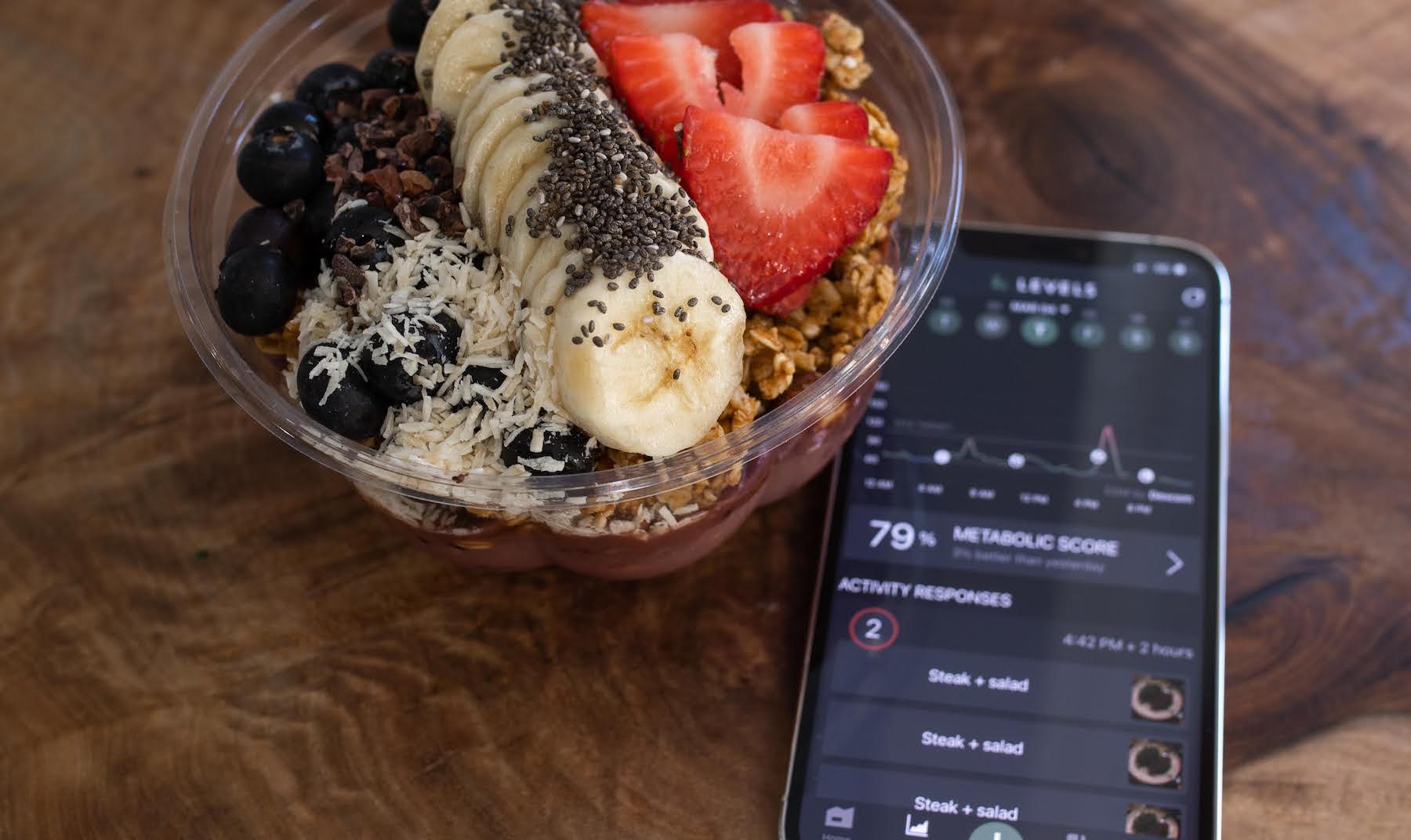We talk a lot about glucose when we focus on metabolic health. After all, it’s the “sugar” in “blood sugar” and what most of the carbs we eat break down into, so it can power our cells or, if there’s excess, be stored for later use.
But the sugar you likely encounter most often in the world is sucrose. First, it’s what you get when you buy a bag of regular white sugar at the store. But it’s also a common added sugar and is found naturally in fruits and vegetables. Both of its parts—glucose and fructose—can have adverse effects on your metabolic health when you consume too much.
Here’s what you need to know about sucrose.
What is Sucrose?
Sucrose is a type of sugar formed by one glucose and one fructose molecule bonded together. This sugar falls into the disaccharide category, which means two monosaccharides (glucose + fructose) linked together by a glycosidic bond.
Sucrose is most commonly known as table sugar. But you’ll also find added sucrose in foods like sugar-sweetened beverages (such as soda or sports drinks), desserts (like cookies and brownies), condiments (ketchup, BBQ sauce), cereals, yogurts, and more. Sucrose is also in natural sources, such as carrots, apples, maple syrup, and, of course, sugar cane and sugar beets.
 Want to see how eating foods with sucrose impacts your blood sugar?
Want to see how eating foods with sucrose impacts your blood sugar?
Levels, the health tech company behind this blog, can help you improve your metabolic health by showing how food and lifestyle impact your blood sugar. Get access to the most advanced continuous glucose monitors (CGM), along with an app that offers personalized guidance so you can build healthy, sustainable habits. Click here to learn more about Levels.
Is Sucrose the Same as Sugar?
Almost—sucrose is a type of sugar. Other names for sucrose include both cane sugar and table sugar.
Sugar is a catchall term for a type of carbohydrate that’s typically sweet and contains calories. Plain white granulated sugar is pure sucrose. Powdered sugar is often sucrose with added corn starch. Brown sugar is mostly sucrose with some molasses. Raw sugar is just sucrose that’s gone through less processing. (None of these are any healthier than the others.)
Other sugars include lactose (the sugar in milk), maltose (found in sweet potatoes), and trehalose (in mushrooms).
What is the Difference Between Glucose, Sucrose, and Fructose?
These are all types of sugars.
Glucose: A monosaccharide, also known as a simple sugar. Glucose comprises 6 carbon, 12 hydrogen, and 6 oxygen atoms (C6, H12, O6).
Found in: Glucose is naturally found in foods such as honey, dried fruit, grapes, sweet corn, and juice.
Related article: What is glucose?
Fructose: Like glucose, fructose is made up of 6 carbon, 12 hydrogen, and 6 oxygen atoms (C6, H12, O6), and it’s also a monosaccharide. Because the atoms are arranged differently from glucose, fructose is sweeter.
Found in: Fructose naturally occurs in coconut sugar, agave syrup, and fruits like apples, and watermelon. It’s also in high-fructose corn syrup, which is part fructose and part glucose.
Related article: Why fructose is bad for metabolic health
Sucrose: This molecule is a disaccharide made up of a glucose and fructose molecule linked together.
Found in: Sugar beets, sugar cane, honey, maple syrup, and other fruits and vegetables, as well as table sugar.
Where Does Sucrose Come From?
Sucrose forms in plants just like other sugars, through photosynthesis, and helps provide energy to the plant.
Foods contain different amounts of sugars. Pears, for instance, have higher fructose than glucose and sucrose. Tomatoes have no sucrose, while sweet peas are all sucrose (but only about 4g per 100g). Sugar beets also contain only sucrose but have 18g per 100g, which is why they’re used to manufacture table sugar, along with sugar cane.

Creating table sugar is a multistep process that involves extracting juice from the cane or beet, refining the sugar liquid multiple times to isolate the sucrose, and ultimately crystallizing the liquid to create dry white sugar.
Is Sucrose a Carbohydrate?
Yes, sucrose is a type of carbohydrate. Carbohydrates are made up of carbon, hydrogen, and oxygen. They are one of the three types of molecules that can be converted to energy in the body, along with fat and protein. During digestion, your body breaks down carbohydrates into glucose, the primary energy source for your cells. Starches (long chains of sugars), sucrose, and lactose are all in the carb category. One teaspoon of sucrose (table sugar) has four grams of carbohydrates with 16 calories.
One sugar molecule or two sugar molecules bonded together is considered a “simple carbohydrate.” Sucrose is a simple carb. A complex carb, on the other hand, has three or more sugars linked together. Fibers and starches are examples of complex carbohydrates.
Our body needs glucose, but in general, we want to get it from foods high in complex carbohydrates (especially fiber) such as vegetables, nuts, seeds, and beans. These not only have more nutrients than foods high in simple carbs (such as candy or baked goods) but also break down more slowly and are less likely to cause blood-sugar spikes.
What Does Sucrose Do to the Body?
No matter how you consume sucrose, an enzyme in your body called sucrase breaks it into glucose and fructose, and these molecules move through different metabolic pathways. Glucose enters your bloodstream, where it prompts the release of insulin. Insulin helps shuttle glucose into your cells for energy or stored as glycogen for later use or as fat. Fructose, however, is metabolized mainly by your liver (and the intestines). It does not trigger an insulin response; however, fructose still can cause significant problems with insulin over the long term by generating fat in the liver, which can make the liver insulin resistant.
Eating small amounts of sucrose through whole, healthy foods like vegetables is unlikely to have a negative impact. There’s no molecular difference between sucrose that comes from natural sources or table sugar, but the fiber in whole foods helps slow down glucose absorption in your body, leading to more stable blood sugar.
However, consuming excess sucrose as an added sugar can have several adverse effects, including blood sugar spikes, insulin resistance and more.
Learn more:
Why We Should Avoid Blood Sugar Spikes
When we take in too many simple carbohydrates, we can sharply raise the amount of glucose in our bloodstream, leading to a blood sugar spike. In the short term, a spike is often followed by a crash—or low glucose levels—as the body works to stabilize blood sugar levels by releasing insulin. These crashes can manifest in several ways, including fatigue, brain fog, anxiety—until your blood glucose returns to homeostasis.
Long-term high insulin levels can create a damaging cycle where cells become “numb” to insulin’s effect. This condition, called insulin resistance, is a primary driver of Type 2 diabetes and can factor in many chronic conditions, including heart disease, infertility, Alzheimer’s disease, and cancer. Nearly 40% of U.S. adults have it, and possibly up to 88%.
In addition, several studies show that consuming added sugars such as sucrose can also lead to weight gain. In a study that looked at the consequences of consuming up to 1.75 liters of a sucrose-sweetened drink (providing 400 to 560 calories per day), people gained four pounds after 12 weeks compared to drinking drinks sweetened with low-calorie sweeteners.
Why Fructose Is Bad for Your Health
In addition to the broader dangers of too much sugar, the fructose component of sucrose has negative health consequences.
Because the liver metabolizes fructose, that’s where the problems begin. With too much fructose, the liver can start turning the sugar into fat, leading to nonalcoholic fatty liver disease (NAFLD), estimated to be present in 25% of people worldwide and as many as 12% of U.S. children. Researchers have shown that even though it’s only half fructose, sucrose consumption can still spur this increased fatty acid production in the liver.
Other effects of excess fructose consumption include insulin resistance, uric acid buildup (which can lead to gout), and inflammation. In addition, several studies show links between excessive fructose consumption and cardiovascular disease risk, metabolic syndrome, and obesity.

 Want to see how eating foods with sucrose impacts your blood sugar?
Want to see how eating foods with sucrose impacts your blood sugar?







